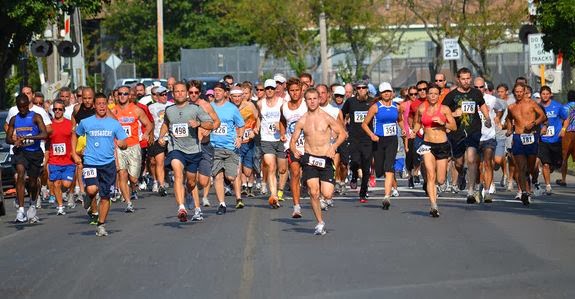Long runs give you a lot of time to think. As I was running, and trying to hit a specific pace for the first 5 miles of my run (which of course ended up being on a steady incline) I had a lot of time to ponder the type of training that I respond to best.
Having had the opportunity to assist in coaching a high school cross country team, and watching Jesse and Shep coach together I have noticed that training needs to be individualized.
One plan does not necessarily fit all. As an Occupational Therapist this idea is very familiar to me. All day long I modify different tasks to help people achieve their highest level of success and independence. This carries into my running and coaching.
So what type of runner are you? You might recognize yourself in one of the descriptions below, or you might like to try out different methods and see which suits you best. If you are training for an event you should always incorporate easy runs, tempo runs, speed work, and hill workouts, but how you approach this workouts will vary. You may find that at different times in your training, the approach you prefer fluctuates.
Pace Oriented: Many people respond to this type of training. This type of runner likes to know exactly what paces to hit, what their splits should look like, and focuses on achieving negative splits in their races (running the second half of the race at a faster pace than the first half). These runners often demonstrate an uncanny ability to mentally crunch numbers and vacillate accurately between miles, kilometers, meters and yards. They know exactly what their pace should be in each measure in order to hit their goal time in a race.
If this describes you, the best way to structure your training is based on these goals. You might like Runner’s World’s Pace Calculator and Pace Wrist Band Creator which tells you what your times should be for each mile to hit a given goal time.
Training: Incorporate pace related goals into all of your training. You should know your paces for the following:
Easy: (talking) pace.
Race pace: The pace you can maintain for a race.
Tempo pace: Comfortably hard, but sustainable for an extended period of time, typically 3-6 miles.
VO2 Max pace: Your hardest working pace. The pace at which you are breathing hard and taking in the maximum amount of oxygen.
Each type of run should have a numerical value/pace attached to it.
Effort Oriented: Some people respond better to training which focuses on their perceived effort during exertion. Studies have shown that the RPE (Rate of Perceived Exertion) is a very accurate rating scale which can be used individually to determine how hard you are working. The Borg RPE scale is rated up to 20, however, a simpler scale of 1-10 is generally sufficient.
Effort oriented runners will often focus on maintaining a certain level of effort in their races. For example, when running up hill their pace slows down as the level of effort goes up. Similarly, when going downhill they don’t relax, they keep their physical level of effort the same.
This type of runner may respond well to training with a heart rate monitor, or may prefer to rely on their own physical experience of the pacing.
The RPE scale is as follows:
0-1 No Effort.
2-3 Light Exertion (stretching/warm up).
4-5 Medium Exertion (you should still be able to talk comfortably). Easy Pace running.
6-7 Moderate Exertion (harder breathing, able to carry on conversation in shorter bursts). Comfortably pushing, you are working hard, but know you can go harder. It feels good to know you don’t have to go harder.
8-9 Hard Exertion (breathing heavy, able to say only a few words at a time. You should wonder how long you can maintain this pace due to increased level of effort). Race Pace. You are working hard, but you can maintain this pace/effort.
10 Maximum/Hardest Level Exertion (as hard/fast as you can go. You should not be able to speak. Typically you can only maintain this pace for up to 1 minute). Sprinting.
Training: Focus your training based on effort. Although you may still have a time goal for a specific event and know your goal paces, maintaining a certain level of effort is more important to your success than pushing to hit your miles at a specific time.
Competitive Spirit: This type of runner responds best to running with a partner or group with a similar level of ability. In races this person is motivated to push as hard as they can to beat those around them. Training with others motivates them to run harder and faster so they can always be their best.
Training: Train in a group, but be sure not to over do it! Easy days should still be easy, not a competition for who has the fastest easy pace. 🙂
Melissa




Awesome analysis! I’m a ‘just gotta do it to get it done’ kinda runner 😉
very useful really good information thanks for posting such a good information it will hepls the people a lot keep it up , Regards, obiee training in hyderabad